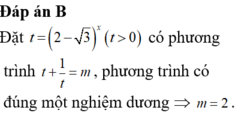
Hãy nhập câu hỏi của bạn vào đây, nếu là tài khoản VIP, bạn sẽ được ưu tiên trả lời.



Vì n là số tự nhiên bé nhất nên n = 30.
b) n = 4
c) n = 16
d) n = 15


a
=>(n+2)=5 :.n+2
=>5:. n+2
=>n+2 E (1,5)
th1
N+2=1
th2 tựlamf

Câu 2. Đặt A=x2+y2+1
Nhập \(2^A=\left(A-2x+1\right)4^x\) vào máy tính Casio. Cho x=0.01, tìm A
Máy sẽ giải ra, A=1.02=1+2x
\(\Leftrightarrow x^2+y^2+1=1+2x\)
\(\Leftrightarrow x^2+y^2-2x=1\)
\(\Leftrightarrow\left(x-1\right)^2+y^2=1\) (C)
Có (C) là đường tròn tâm (1,0) bán kính R=1
Lại có: P=\(\frac{8x+4}{2x-y+1}\)
\(\Leftrightarrow x\left(2P-8\right)-yP+P-4=0\) (Q)
Có (Q) là phương trình đường thẳng.
Để x,y có nghiệm thì đường thẳng và đường tròn giao nhau nghĩa là d(I,(Q))\(\le R\)
\(\Leftrightarrow\frac{\left|x\left(2P-8\right)-yP+P-4\right|}{\sqrt{\left(2P-8\right)^2+P^2}}\le1\)
\(\Leftrightarrow\frac{\left|2P-8+P-4\right|}{\sqrt{\left(2P-8\right)^2+1}}\le1\)
\(\Leftrightarrow\left(3P-12\right)^2\le5P^2-32P+64\)
\(\Leftrightarrow4P^2-40P+80\le0\)
\(\Leftrightarrow5-\sqrt{5}\le P\le5+\sqrt{5}\)
Vậy GTNN của P gần số 3 nhất. Chọn C

1/ \(f'\left(x\right)=\frac{3\sqrt{x^2+1}-\frac{x\left(3x+1\right)}{\sqrt{x^2+1}}}{x^2+1}=\frac{3\left(x^2+1\right)-3x^2-x}{\left(x^2+1\right)\sqrt{x^2+1}}=\frac{3-x}{\left(x^2+1\right)\sqrt{x^2+1}}\)
Hàm số đồng biến trên \(\left(-\infty;3\right)\) nghịch biến trên \(\left(3;+\infty\right)\)
\(\Rightarrow f\left(x\right)\) đạt GTLN tại \(x=3\)
\(f\left(x\right)_{max}=f\left(3\right)=\frac{10}{\sqrt{10}}=\sqrt{10}\)
2/ \(y'=\frac{\sqrt{x^2+2}-\frac{\left(x-1\right)x}{\sqrt{x^2+2}}}{x^2+2}=\frac{x^2+2-x^2+x}{\left(x^2+2\right)\sqrt{x^2+2}}=\frac{x+2}{\left(x^2+2\right)\sqrt{x^2+2}}\)
\(f'\left(x\right)=0\Rightarrow x=-2\in\left[-3;0\right]\)
\(y\left(-3\right)=-\frac{4\sqrt{11}}{11}\) ; \(y\left(-2\right)=-\frac{\sqrt{6}}{2}\) ; \(y\left(0\right)=-\frac{\sqrt{2}}{2}\)
\(\Rightarrow\left\{{}\begin{matrix}M=-\frac{\sqrt{2}}{2}\\N=-\frac{\sqrt{6}}{2}\end{matrix}\right.\) \(\Rightarrow MN=\frac{\sqrt{12}}{4}=\frac{\sqrt{3}}{2}\)
Tất cả các đáp án đều sai
3/ \(\left\{{}\begin{matrix}\left|x-3\right|\ge0\\\sqrt{x+1}>0\end{matrix}\right.\) \(\Rightarrow f\left(x\right)\ge0\) \(\forall x\Rightarrow N=0\) khi \(x=3\)
- Với \(0\le x< 3\Rightarrow f\left(x\right)=\left(3-x\right)\sqrt{x+1}\)
\(\Rightarrow f'\left(x\right)=-\sqrt{x+1}+\frac{\left(3-x\right)}{2\sqrt{x+1}}=\frac{-2\left(x+1\right)+3-x}{2\sqrt{x+1}}=\frac{-3x+1}{2\sqrt{x+1}}\)
\(f'\left(x\right)=0\Rightarrow x=\frac{1}{3}\)
- Với \(3< x\le4\Rightarrow f\left(x\right)=\left(x-3\right)\sqrt{x+1}\)
\(\Rightarrow f'\left(x\right)=\sqrt{x+1}+\frac{x-3}{2\sqrt{x+1}}=\frac{2\left(x+1\right)+x-3}{2\sqrt{x+1}}=\frac{3x-1}{2\sqrt{x+1}}>0\) \(\forall x>3\)
Ta có: \(f\left(0\right)=3\) ; \(f\left(\frac{1}{3}\right)=\frac{16\sqrt{3}}{9}\) ; \(f\left(4\right)=\sqrt{5}\)
\(\Rightarrow M=\frac{16\sqrt{3}}{9}\Rightarrow M+2N=\frac{16\sqrt{3}}{9}\)
Câu 2 hình như câu B mà người ta nói đạt GTLN . GTNN tại M , N nên là 0 x -2 =0


n ≥ log 1 2 10 - 9 ⇔ n ≥ 9 log 2 10 ≈ 29 , 897
Vì n là số tự nhiên bé nhất nên n = 30.